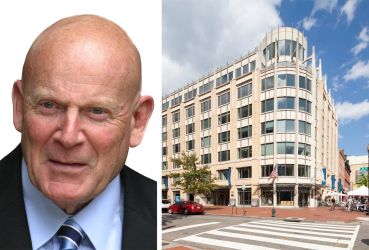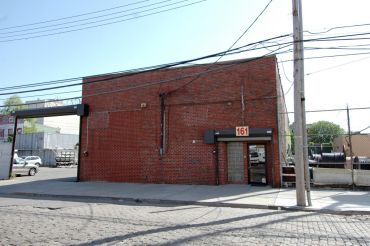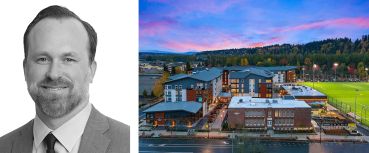Harbor Group International’s Jordan Slone Is Not Worried
He's pretty sure what office tenants want — just look at what's happening at Manhattan's Black Rock
By Tom Acitelli January 9, 2024 9:00 am
reprints
The commercial real estate market right now craves certainty and calm. So, if Jordan Slone could bottle and sell his take on it going into 2024, he’d make a mint.
The chairman and chief executive of Harbor Group International (HGI) does foresee what he called in a late December interview with Commercial Observer “a tsunami of distress” careening toward the market. But he also coolly leans on trend lines and the data behind them to guide what’s become one of the more successful real estate investment firms out of the pandemic.
Take what’s happening at the 38-story office building at 51 West 52nd Street — the Modernist monolith designed by Eero Saarinen that’s often called Black Rock (for its look, not for any association with the identically named asset manager). HGI bought it from ViacomCBS in August 2021 for $760 million in what was for the private Norfolk, Va.-based firm a rare office purchase in New York City. It was also the first time the building had traded since it opened in 1964.
Buying office in mid-2021 would today be akin to donating heavily to DeSantis 2024. There were better ways to spend money.
Yet, HGI saw around the corner to a reality where top-tier office space would absorb much of the interest from marquee corporate tenants while lesser buildings struggled or simply disappeared into the ether of conversion. The company repositioned Black Rock, including $128 million in renovations and amenities, and more than two years later the tower now stands among the more desirable in New York, with occupancy over 90 percent and rents starting at $90 a square foot.
HGI has some $19 billion in investment properties, particularly office and multifamily. Its financing operation runs the gamut, too, including bridge, preferred equity and mezzanine loans in multifamily as well as preferred equity and mezzanine in office. Slone — who helped launch HGI in the mid-1980s out of his family’s box-spring business (really) — spoke with CO via a video chat about all this and more.
This interview has been edited for length and clarity.
Commercial Observer: Let’s start with what’s going on at Black Rock. Harbor Group is spending quite a bit on customizing the individual offices and upgrading the amenities. What’s the grand strategy there?
Jordan Slone: I don’t know how much you know about the building itself, but it’s the only office building that Eero Saarinen ever designed. We have really brought the building back to its glorious state. If you know much about the office building business, you know, a lot of times that corporate headquarters become more like somebody’s house than an office building for multiple tenants. The building had never been sold in its history — CBS built it, and they were the only owner until we bought it in 2021.
One example of what I’m talking about is there were these magnificent bronze fins that run on both walls of the lobby. Sometime during CBS’s ownership, they covered them over with black paint. We somehow discovered there were these bronze fins. And we stripped them all so they look like new, and it’s just amazing. Anyway, fast forward and we have also made the building fully amenitized with best-in-class amenities: fitness centers, yoga studios, grab-and-go lunch facilities, conference rooms, breakout rooms and lounges. We have an infinity pool where when you walk down the stairs it looks like you’re going to walk right into the pool. We’ve redone the elevators. It’s just beautiful.
Did it work?
We bought the building from ViacomCBS, and they occupied about a third of the building. When we bought it from them, the idea was that they would be moving out. Most of their lease was a two-year lease, and a small portion was a three-year lease. So the two-year lease has come and gone, and they’ve essentially vacated all of their space — even the space that they’re still actually renting for another year. There’s nobody occupying it.
So we took back a little less than 300,000 square feet. We have already leased over 100,000 square feet of the 300,000. And we are currently working on and are very, very close to announcing another 100,000 square feet of lease deals.
When will that happen?
I would like it to happen, I hope, in the next 30 days.
So by the end of January you might have 100,000 square feet more in leases?
That’s right.
In addition to that, we renewed the largest tenant in the building, which is the Wachtell Lipton law firm. Now, in two years’ time, amazingly, we have already renewed and/or leased 41 percent of the total square footage of the building, and all of the new leases that we’ve done — there have been four new leases — have all been between 11 and 17 years.
That’s unusual in Manhattan right now.
That’s a good lead-in to what’s happening in the market now. The best buildings — if you take the top 5 percent of Manhattan buildings — believe it or not they’re actually doing very, very well.
Work from home was great when everybody needed to do it, but now most of the big companies — big law firms, big accounting firms, investment firms, banks, etc. — really want people back in the office, not necessarily every day but most days of the week. How do you get them excited about coming to the office? You get them excited about coming to the office by having a magnificent place they can come to every day.
Our Black Rock, by the way, takes up an entire city block and has unobstructed views from all four sides with floor-to-ceiling windows. Tenants are moving to buildings like that as a way to get their employees really excited about coming to the office.
What happens to the non-Black Rocks then?
I’ll give you a short answer, and I’ll divide the answer into two parts.
Part A is that the buildings that are still functional as office buildings — they’re not necessarily in the top tier but they are still reasonably good quality office buildings in good locations — those buildings will come back. They will just be the second wave of the comeback. When the best buildings no longer have space in them, they’ll benefit as their occupancy improves.
The second part of my answer is that the buildings that are really old, have a lot of functional obsolescence — no views, no amenities — those buildings will hopefully be retrofitted into something else. As you know, there’s a push to convert a lot of these old buildings into housing.
Is Harbor Group interested in getting into that?
No, we’re not really interested in getting into that. But we do think it makes sense. A lot of buildings don’t lend themselves to that type of conversion, but the ones that do — it’s a win-win situation because it can create more housing, affordable housing, and also take out functionally obsolete, unnecessary office inventory from the market.
I do want to get to housing. But a couple of more questions about Black Rock. Are you offering incentives to tenants?
We’re not offering any nonstandard incentives. In the office building business, typically, depending on the length of the lease, tenants get a certain amount of free rent. A lot of that goes toward the time it takes to build out their space. Then there’s also the tenant improvement allowances. But most tenants spend a lot more than the tenant improvement allowance.
Besides law firms, what’s the tenant mix like?
The new deals that we’ve done, there’s two private equity firms. One of those firms is Harbor Group. We have moved our offices to the building. We were on Bryant Park — great location but small floors. We have moved into one large floor, which works great for us. The other private equity firm is focused on buying equity stakes in businesses. One of the largest pension fund advisers in North America is another tenant. Another tenant is an insurance company.
Is Harbor Group planning any other office acquisitions in New York?
At the present time, no. We really wanted to finish the reposition and the lease-up on the Black Rock building, and then we’ll consider investing in other office buildings in New York. However, as you may know, Harbor Group is a lender as well. And we are looking to do mezzanine and preferred equity investments in New York office.
Where’s Harbor Group’s financing platform busiest now?
We’re very active in buying bonds. On the multifamily side, we’re very active Freddie Mac bond buyers. We also buy bonds from CLOs, and we also buy bonds on the secondary market, and we do that through our multifamily credit fund. We also have a commercial credit fund through which we’re buying bonds.
Our multifamily credit fund does first mortgages as well as mezzanine financing and preferred equity. We do not provide first mortgages on commercial office buildings, but we do do mezz and preferred equity.
Is that just because of the situation in the office market now?
Yes, but it’s a little bit more complicated than that. It has to do also with the securitization market. When we get first mortgages, we oftentimes securitize them, and the securitization market is not really there — I don’t want to say it’s not there, but it hasn’t really come back yet enough for us.
The multifamily fund you were talking about — is that the $1.6 billion one from last January?
Correct.
You’re still spending that, right?
Oh, yeah. As we speak, we have about $750 million left to deploy.
Where would you deploy it? In what sort of properties?
Again, it would only deploy into multi-family properties. We’re deploying it into senior markets. We’re deploying it into mezzanine loans and private equity investments. Lastly, we’re deploying it into bonds.

Do you look at geography at all?
Yes, of course we look at geography. When you buy bonds, sometimes you are getting a portfolio of properties in many different markets.
We’re not agnostic about where we go. We were talking about lending. Sometimes the markets we look at for lending versus the markets where we look to own, usually there’s a huge overlap. But there can be a huge spillover when it comes to lending because when you buy bonds, again, you’re getting whatever’s in those bonds. You might not like a particular state, but sometimes you get some of that when you buy a bond.
In terms of where we focus to own, we do like the Sun Belt markets still. We also like up and down the East Coast, for the most part. Boston has been a very active market for us. We’ve bought and sold a lot of properties there over the last five years. Most recently, this past summer, we sold a portfolio there for $465 million. We are actively looking to buy more in Boston. That’s been a very good market for us.
Harbor Group does some new development as well. We’ve done it in Connecticut, we’re looking at doing something in New Jersey. As we move south — Virginia, the Carolinas, we like the Carolinas a lot. We’ve been very active in the Carolinas over the last several years, including places like Charleston and Myrtle Beach. Then, in Florida, we’ve been, if not the No. 1 then certainly among the top three most active buyers in South Florida over the last three or four years.
Why is that? Just because the fundamentals work?
The fundamentals are very good. Florida’s still getting a lot of in-migration — companies are moving there, people are moving there, retirees are moving there. There’s a lot of favorable characteristics about Florida, not the least of which is no state tax.
There is overbuilding in multifamily in much of the country — too many apartments coming online. Does that worry you?
You’re right in terms of what has been delivered over the last couple of years and what’s being delivered in 2023. However, if you look at permits and starts as we go forward, they’re down.
I will tell you, if you speak to most multifamily experts, most will predict we’re going to see very, very strong multifamily fundamentals starting in, let’s say, the second half of 2025 going into 2026 as the new construction deliveries get absorbed.
So, you’re right that there has been over the last couple of years a lot of deliveries — and that also comes over into 2023 as well. But if you look at permits and new starts recently, then the deliveries go down in 2024, and go way down in 2025.
How about single-family rental? Harbor Group is financially backing a single-family rental project along South Carolina’s Grand Strand. What sort of growth do you see with single-family rentals?
It’s an entry point for us. We like the business. We plan on doing more in that segment.
The cost of a mortgage today is very expensive as is the cost of housing, the cost of building the house, the labor, everything else that goes into it. But if you have a family — kids, pets — people really like living in a house with a yard. There’s definitely a market for it. Not only are we seeing it, but if you read most research reports, they’re predicting very good fundamentals for that segment.
So the South Carolina project is Harbor Group’s first in single-family rental?
This, I believe, will be our first equity ownership. We’ve done financing before.
In general for 2024, where do you foresee being busiest?
I think there will be a lot of distress in 2024 — a lot of distress. Somebody asked me just recently, “Well, with interest rates trending down in the last 60 days or 45 days, is that gonna blow the whole theory that there’s gonna be tremendous distress?” It’s definitely not. I’m telling you I’m extremely confident we’re going to see a wall of distressed deals — a tsunami of distressed deals — in 2024.
The reason for that is that there is a tremendous amount of loans maturing in 2024, and those loans will not be able to be refinanced. There’s also still a tremendous amount of floating-rate debt. And, even though long-term rates have come down significantly, short-term rates have not come down as much.
I imagine Harbor Group is positioned to capitalize?
Yes. We’ve always done some fee management. Most of what we manage we own, but we also do some management for others. That is an area that we’ve started ramping up because as lenders take back properties, they need property management. We are doing more of that.
Tom Acitelli can be reached at tacitelli@commercialobserver.com.


